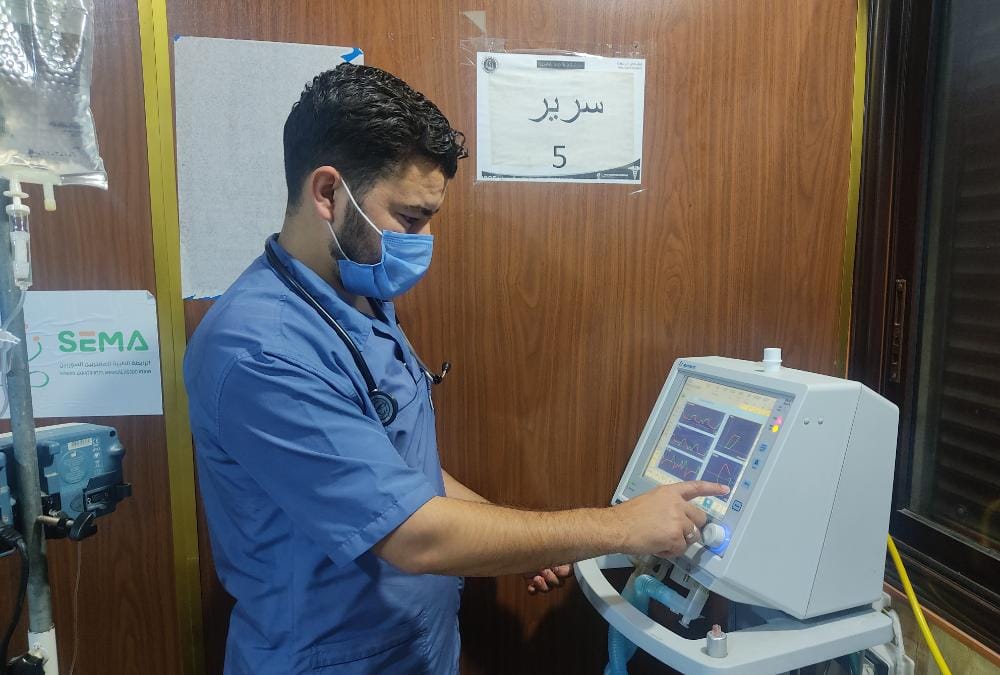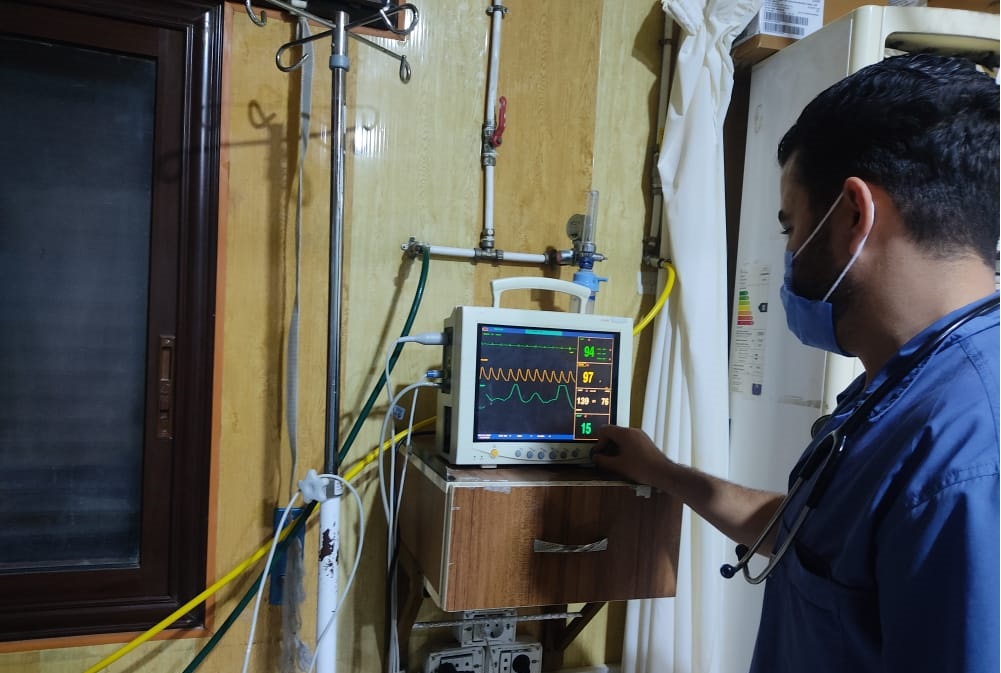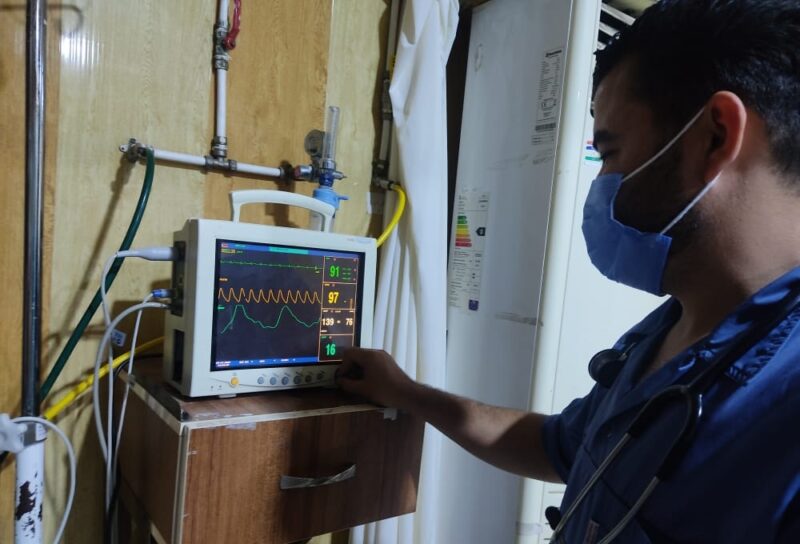Case History:
A 70-year-old patient was brought to the ER at Al-Rahma Darkush Hospital supported by the Syrian Expatriate Medical Association (SEMA). The resident doctor in the Department of Internal Medicine, Dr. Qusai Rashwani met the patient who came with a story of severe respiratory dyspnea, peripheral cyanosis and cold extremities, profuse sweating, irritability, dry cough, and deterioration of consciousness.
Medical history: bronchial asthma and high arterial tension.
Clinical examination:
Vital signs: pressure 116/62 mm Hg, pulse 100/m, oxygen 75%.
General condition: The patient was conscious, unresponsive, and undirected with severe respiratory dyspnea.
Chest listening: The chest was silent, and the examination was normal.
The patient has been diagnosed with a severe asthmatic condition.
Initial measure:
The patient was placed on a high-flow oxygen mask of 10 L/m, with the opening of an intravenous line and the patient was given inhaled bronchodilators and short-term beta stimulants salbutamol continuous spray, with short-term anticholinergic ipratropium, then administered to the patient 200 mg hydrocortisone. But there was no improvement in the patient’s case and the respiratory dyspnea increased and there was a deterioration in consciousness. so, Dr. Nassima Ghazal, a supervising pulmonary disease specialist, decided to transfer the patient to the intensive care department and apply magnesium sulfate 2 G within 100 saline serums, within 20 minutes. But the respiratory dyspnea and deterioration of consciousness continued, and the patient developed arterial hypotension 80/ 50 mm Hg. Then the decision was to put the patient on the automatic ventilation device, but during the intubation, the patient developed cardiac arrest, the team performed cardiopulmonary resuscitation for two minutes then the sinus heart rhythm was restored, and the patient was placed on the automatic ventilation device with the adoption of the following asthma status settings:
- VCV System
- Tidal Volume TV: 6-8ml/kg of ideal weight
- Number of breathing movements: 8-14 movements per minute
- High flow rate of 60 L/min
- Inhalation-to-exhalation ratio 1:4-1:5
- PEEP value for first 2 hours then raises the value to 3-5
The patient was relaxed with ketamine and midazolam while continuing with corticosteroids and bronchodilators in addition to observation.
Follow-up:
The patient was followed, and after 12 hours there was an improvement in oxygen saturation SPO2=94 with improvement in consciousness. Then the team decided to wean the patient off the automatic ventilation device when the vital signs became stable (pulse 91 /m, pressure 151/96 mm Hg, and oxygenation 95%). The next day the patient was discharged to the ward in good general condition and remained in the ward for 24 hours and then discharged home in good general condition with the prescription of appropriate medications for the condition.
Discussion:
Definition of asthmatic condition: is a severe exacerbation in asthma patients that do not require treatment with bronchodilators and cortical steroids and is considered a life-threatening condition caused by obstruction of the respiratory airways. Treatment of the asthmatic condition in ER includes:
- Add oxygen to high seas
- Inhaled bronchodilators (fast-acting beta agonist SABA+ short-acting muscarinic (anti-cholinergic) agonist SAMA)
- Systemic steroids which are the cornerstone of treatment (methylprednisolone 1-2 mg/kg or hydrocortisone)
- Magnesium sulfate 2 g within 20 minutes in 100 ml systemic saline or glucose serum
The patient’s condition in the ER did not respond to previous treatments, so she was admitted to the intensive care unit, the criteria for admitting an asthmatic patient to intensive care include:
- Failure to improve despite adequate treatment with bronchodilators (as in the case of this patient)
- Silent chest (as in the case of this patient)
- High CO2 despite treatment
- Presence of risk factors (previous admission in ICU + automated ventilator)
After the deterioration of the patient’s consciousness and the hemodynamic condition was placed on automatic ventilation, and the indications of automatic ventilation include:
- Apnea (which occurred in the patient in intensive care)
- Deterioration of consciousness (as in the case of the patient)
- Impending respiratory insufficiency
- Intractable hypoxia (as in the case of the patient)
Intubation in patients with asthmatic condition carries a high risk of cardiac arrest and the intubation requires the presence of an experienced person with close monitoring during the first hours. A suitable tube with a large diameter of 8 in men and 7.5 in females should be used. Ketamine or propofol has also been used because they carry the property of bronchodilation. The ventilator settings are usually adjusted as follows:
- Initial processing under close guidance to prevent the formation of auto-peep
- Use low volumes of 6-8 ml/kg
- Low breathing movements 8-14/min
- High flow rate of about 60 L/min
- Low PEEP value mode between 3-5




